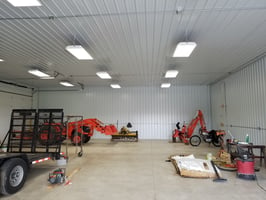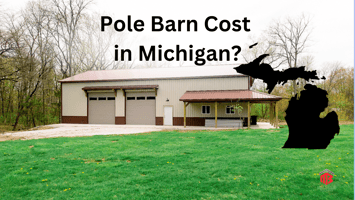As snow and cold have been hitting the US this month, we hope all are staying warm in their homes....
Spray Foam Insulation on Steel
Can I spray foam on Steel on my Pole Barn?
Spraying foam on steel can be a practical and effective insulation solution
One topic that we often encounter from our clients is the practicality of spraying foam on steel for their pole barn. With the rising popularity and increasing demand for energy-efficient buildings, it is crucial to explore the factors to consider with this insulation method.
In this article, we will look at the details and provide insights into the viability of this approach.
Understanding the Benefits of Spraying Foam on Steel
Spraying foam insulation on steel structures offers numerous benefits for pole barn buildings. Some of these benefits include
-
Enhanced Energy Efficiency: Spray foam insulation provides exceptional thermal insulation properties, minimizing heat transfer and reducing energy consumption. By creating an airtight seal, it prevents air leakage and eliminates drafts, resulting in lower heating and cooling costs.
-
Air and Moisture Barrier: Foam insulation acts as an effective air and moisture barrier, creating a sealed envelope for the building. This eliminates air infiltration and prevents moisture from seeping into the structure, reducing the risk of mold, rot, and other moisture – related issues.
-
Noise Reduction: One often overlooked benefit of spray foam insulation is it’s ability to reduce noise transmission. The dense and flexible nature of the foam absorbs sound waves, creating a quieter and more comfortable interior environment, whether it’s a workshop, storage area or living space.
-
Enhanced Structural Integrity: The application of spray foam on steel can enhance the structural integrity of the building. The foam adheres to the surface, providing rigidity and reducing the risk of movement or shifting over time. This added stability can be particularly beneficial in areas prone to high winds or seismic activity.

Evaluating the Practicality of Spraying Foam on Steel
While spraying foam on steel offers significant benefits, it’s important to consider certain factors to determine its practicality for your post-frame building.
Let’s address some common concerns and explore potential solutions:
-
Cost Considerations
Spray foam insulation can be more expensive than traditional insulation methods. However, it is essential to evaluate the long-term benefits and potential energy savings that foam insulation can provide. The increased energy efficiency of the building may offset the initial investment over time.
Factors that influence the cost of the spray foam insulation include the size and complexity of the building, the thickness of the insulation and regional labor and material costs.
-
Code Requirements
Before proceeding with foam insulation, it is crucial to ensure compliance with local building codes. Some jurisdictions may have specific regulations regarding the use of foam insulation, particularly when it comes to safety.
The experts at Milmar can help you navigate these requirements.
-
Compatibility with Metal Siding
A common argument amongst builders is the issue of applying closed-cell foam insulation directly to metal siding can create problems such that the expansion and contraction of the metal due to temperature fluctuations may cause the foam to detach over time.
Additionally, condensation could accumulate between the siding and the foam, potentially leading to rot and structure damage.
While these concerns may exist, it is important to note that proper installation and appropriate building design can mitigate these risks.
It’s always best to consult us at Milmar when in need of spray foam insulation, as well as considering alternative insulation options, such as SIP panels, to help you make an informed decision.

Creative Solutions for Spraying Foam on Steel
If you are looking for creative ideas to incorporate spray foam insulation on your steel pole barn, consider the following options:
Combination of Spray Foam and Fiberglass Insulation
One Approach is to combine spray foam insulation with traditional fiberglass insulation.
This method involves spraying the foam directly onto the steel roof panels and then fitting fiberglass insulation in the remaining wall air gap. This combination provides both a thermal break and additional insulation, creating a well-insulated and energy-efficient building.
To further enhance the insulation, consider cutting the fiberglass insulation to fit in between the purlins, eliminating any potential air gaps and ensuring a more thorough insulation barrier.
To wrap up, spraying foam on steel for pole barn buildings can have a practical and effective insulation solution. By leveraging the benefits of spray foam insulation, you can create a comfortable and energy-efficient space. While cost considerations and code requirements should be taken into account, using spray foam insulation with creative solutions can help address potential concerns.
Whether you choose the combination of fiberglass and spray foam insulation or fully spray foam, consulting with professionals and adhering to best practices will ensure a successful insulation project.
Milmar Buildings is ready to assist you with your post-frame building project. Speak with our experts today!
If you have any additional inquiries that haven’t been addressed in this article, please don’t hesitate to reach out. For assistance with designing and planning your project, you can contact Milmar Buildings at 260-440-3190 or send us an email by clicking here. Our dedicated Customer Engagement Team will be happy to assist you in determining the next steps for your project.




